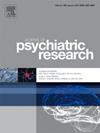Dysfunctional activation of the default mode network in response inhibition in schizophrenia
IF 3.7
2区 医学
Q1 PSYCHIATRY
引用次数: 0
Abstract
The aim of this study was to characterize dysfunctional cerebral activation in patients with schizophrenia while they performed a response inhibition task. To achieve this, performance on the task and functional magnetic resonance imaging (fMRI) were compared between healthy control subjects (HC) and patients with schizophrenia (SZ). We focused on the default mode network (DMN), as there is strong evidence in the literature that lack of DMN suppression in schizophrenia is associated with cognitive impairment including poor response inhibition. fMRI was used to measure blood-oxygen-level-dependent activation in 84 subjects (44 SZ and 40 HC) while they performed a Go NoGo task. The subjects were also evaluated for psychiatric symptoms and immediate visual memory.
SZ performed more poorly than HC on the task; they had a higher number of commission errors. On the fMRI, the patients consistently evidenced higher activation than the controls in several areas of the default mode network (DMN) including the precuneus, rostral anterior cingulate, parahippocampus and insula. The higher brain activation in the patients with schizophrenia indicates a failure to deactivate the DMN while they perform the response inhibition task. These findings point to the importance of DMN dysfunction as an underlying cause of impairment in response inhibition in schizophrenia. DMN disruptions play an essential role in the cognitive impairment present in schizophrenia.
精神分裂症患者反应抑制过程中默认模式网络的功能失调。
本研究旨在描述精神分裂症患者在执行反应抑制任务时大脑激活功能障碍的特征。为此,我们比较了健康对照组(HC)和精神分裂症患者(SZ)在该任务中的表现和功能磁共振成像(fMRI)。我们的研究重点是默认模式网络(DMN),因为有充分的文献证据表明,精神分裂症患者的默认模式网络抑制功能缺失与认知功能障碍(包括反应抑制能力差)有关。同时还对受试者的精神症状和即时视觉记忆进行了评估。在这项任务中,SZ 的表现比 HC 更差;他们的犯错次数更高。在 fMRI 上,患者默认模式网络(DMN)的几个区域,包括楔前肌、喙状前扣带回、副海马和岛叶的激活程度始终高于对照组。精神分裂症患者的大脑激活程度较高,这表明他们在执行反应抑制任务时未能使默认模式网络失活。这些研究结果表明,DMN功能失调是精神分裂症患者反应抑制能力受损的重要原因。DMN功能紊乱在精神分裂症患者的认知障碍中起着至关重要的作用。
本文章由计算机程序翻译,如有差异,请以英文原文为准。
求助全文
约1分钟内获得全文
求助全文
来源期刊

Journal of psychiatric research
医学-精神病学
CiteScore
7.30
自引率
2.10%
发文量
622
审稿时长
130 days
期刊介绍:
Founded in 1961 to report on the latest work in psychiatry and cognate disciplines, the Journal of Psychiatric Research is dedicated to innovative and timely studies of four important areas of research:
(1) clinical studies of all disciplines relating to psychiatric illness, as well as normal human behaviour, including biochemical, physiological, genetic, environmental, social, psychological and epidemiological factors;
(2) basic studies pertaining to psychiatry in such fields as neuropsychopharmacology, neuroendocrinology, electrophysiology, genetics, experimental psychology and epidemiology;
(3) the growing application of clinical laboratory techniques in psychiatry, including imagery and spectroscopy of the brain, molecular biology and computer sciences;
 求助内容:
求助内容: 应助结果提醒方式:
应助结果提醒方式:


